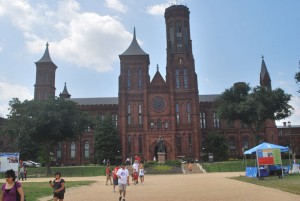
Photo: Smithsonian Institution Credit: Peter Griffin Source
from History.com
After a decade of debate about how best to spend a bequest left to America from an obscure English scientist, President James K. Polk signs the Smithsonian Institution Act into law.
In 1829, James Smithson died in Italy, leaving behind a will with a peculiar footnote. In the event that his only nephew died without any heirs, Smithson decreed that the whole of his estate would go to “the United States of America, to found at Washington, under the name of the Smithsonian Institution, an Establishment for the increase and diffusion of knowledge.” Smithson’s curious bequest to a country that he had never visited aroused significant attention on both sides of the Atlantic. . . . Read Complete Report
Invited Comment by Rick Osmon
Dennis has invited me to provide a bit of commentary on this particular story because he knows I continue to express profound doubt in the top level integrity of the Smithsonian Institution.
The Smithsonian is unique in several respects. It is considered by Federal law to be a private institution, yet when it goes to collect specimens it claims it carries the weight of law, in some cases, to force collection.
The Smithsonian claims to house in its collection more than 136 million artifacts, yet, when one inquires about any artifact or group of artifacts listed in old newspapers or scientific journals, sometimes the Smithsonian’s own reports. If those artifacts are not on display, they rarely can be found at all. I have no doubt that most of the artifacts or remains that have been sought by disappointed researchers are or were within the institution, but for decades certain classes of specimen are simply not available for study even by profoundly qualified researchers. The most repeated story of this type goes to skeletal remains of either North American giants or of North American pygmies. Dozens of newspaper accounts from the 19th and early 20th centuries describe such remains being excavated, packaged, and sent to the Smithsonian by archaeologists who were either directly dispatched by the institution or had some close tie to it.
Many people both within and outside of the Smithsonian say that the institution is not a government body so therefore Freedom of Information Act requests (FOIA) would not apply. However, the Smithsonian Institution was established by an act of Congress, regardless that the initial funding was a bequest. While the Smithsonian today receives virtually no direct funding from the Federal government, their research tasks are funded by the National Science Foundation, a mixture of public and private funds administered and governed at the top level by the Rockefeller Foundation. This results in “scientific research” that picks chooses what they want the public to know and ignoring, hiding, or even destroying evidence that doesn’t fit the “mission”. This is particularly true of giants, pygmies, pre-Columbian contact, or lost civilizations. The Smithsonian is the de facto “keeper of the Hidden History”.
Rick Osmon







Leave a Reply